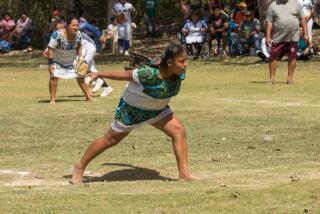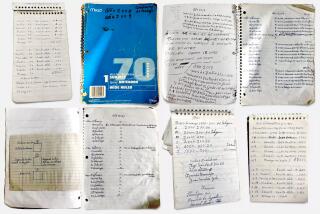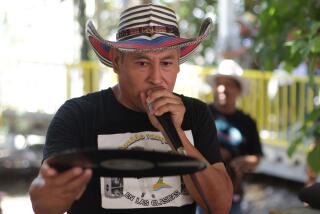Peru’s Shantytown R&D; Laboratories
LIMA, Peru — When a fall down a flight of stairs left Jose Juape’s beloved grandmother unable to walk and the family couldn’t afford a wheelchair, he set out to build her a remote-control robot.
As the 80-year-old matriarch sat motionless on a ragged sofa in their home abutting a dusty street market in the Lima shantytown of Comas, Juape, then 14, rooted through junkyards for parts.
He scrounged old air conditioner motors, pulleys, wires and an ancient car battery to power the robot.
After more than a year of experimenting, Juape, who knows little math or science, built “The Condor,” a man-size robot covered in tin foil that can roll about the house on wheels, pick up objects with pincer-like hands and turn its head. It is operated by a hand-held control panel.
“If you can’t buy something in Peru, you make it yourself,” said Juape, whose next project is to make an electricity generator from scrounged magnets.
Of course, the results aren’t always what’s planned. Juape’s grandmother is afraid of the robot, calling it “the dead soul.”
Peru’s sprawling shantytowns are hot beds of creativity. Spurred by desperate poverty, their inhabitants are inventing their own machines and building everything from toys to car parts from junk.
A national inventors contest attracted hundreds of entries, including a snail-shaped concert harp, acne cream made from tree bark, socks that give a massage and a combination bed, chair and urinal.
Many of the best inventions came from the poor, said Isaias Flit, a lawyer with Peru’s copyright office, Indecopi, which organized the event.
“There is a phenomenal creativity among Peruvians, especially the poor, who trace their roots back to the rich Inca or pre-Inca Indian cultures,” said Luis Herrera, a psychoanalyst who studies Peru’s poor. “This creativity emerges in times of crisis.”
Peru was the center for many of Latin America’s great Indian cultures.
Peruvian inventors last year won gold medals in two categories at the International Exhibition of Inventions, New Techniques and Products, an inventors contest held in Switzerland that attracted participants from more than 50 countries. There were 22 categories.
Peru’s performance was the best of any Latin American country, Flit said.
One medal went to a man from the ancient Incan capital of Cuzco in the Andes who invented an electronic pen that detects forged signatures. Using seismic technology available in earthquake-prone Peru, Luis Jimenez’s pen measures the pressure and motion with which a name is signed.
The second medal went to Carlos Passaro, an unemployed mural painter who invented a multiuse life preserver/swimming aid. It is a long, flexible foam tube and plastic clamp that can fold the tube into 20 positions, including one that leaves the swimmer sitting in the water as if in a chair.
Peruvians had to begin looking for creative ways to survive following the collapse of their economy in the 1980s and early 1990s.
Conditions of the urban poor were worsened by the mass migration of Indians from the countryside to the cities to get out of the cross-fire in the long war between leftist guerrillas and the army.
An estimated 600,000 people fled to urban areas. Many squatted on unoccupied land, forming a vast “misery belt” on the desolate desert sands around Lima in a social cataclysm that changed the face of Peru.
Under the misgovernment of populist President Alan Garcia, the economy collapsed and inflation soared to 7,000% in 1990.
By the early 1990s, 60% of Peruvians lived in poverty, one in five lived in complete misery and the rural social structures that had sustained migrants in their former communities were in tatters.
The Andean migrants built their homes from straw, cardboard and garbage on plots of sand without running water, electricity, schools or roads. Almost overnight new shantytowns appeared. Hunger loomed.
“They lived in a wasteland one step away from starvation. Faced with this adversity, they used their native creativity to come up with ingenious ways to survive,” said the Rev. Tom Burns, an American Maryknoll priest who has worked among Peru’s poor for 29 years.
The poor taught themselves to be electricians, plumbers, mechanics, urban planners and repairmen, he said. Before Christmas, self-taught toy makers visit shantytowns and rural villages holding toy fairs.
During his studies of shantytown psychology, Herrera found blocks of mechanics who had never read a manual but could rebuild cars from scrap and street markets filled with rejiggered appliances. He also found forgers who could expertly fake everything from money to medical degrees.
These self-taught skills and abilities have led to inventions, few of which are patented, said inventor Passaro, who lives in a tough part of downtown Lima.
Passaro has invented more than a dozen items, including special mural-painting brushes and giant hand puppets operated by piano-like keys.
He built the swimming aid to help his wife learn how to swim and the hand puppets so that the school where his wife taught could put on a show even though it had no money.
“Everything I invent is a response to a need,” he said. “If I sat on my hands and did nothing, we would have nothing.”
More to Read
Inside the business of entertainment
The Wide Shot brings you news, analysis and insights on everything from streaming wars to production — and what it all means for the future.
You may occasionally receive promotional content from the Los Angeles Times.










